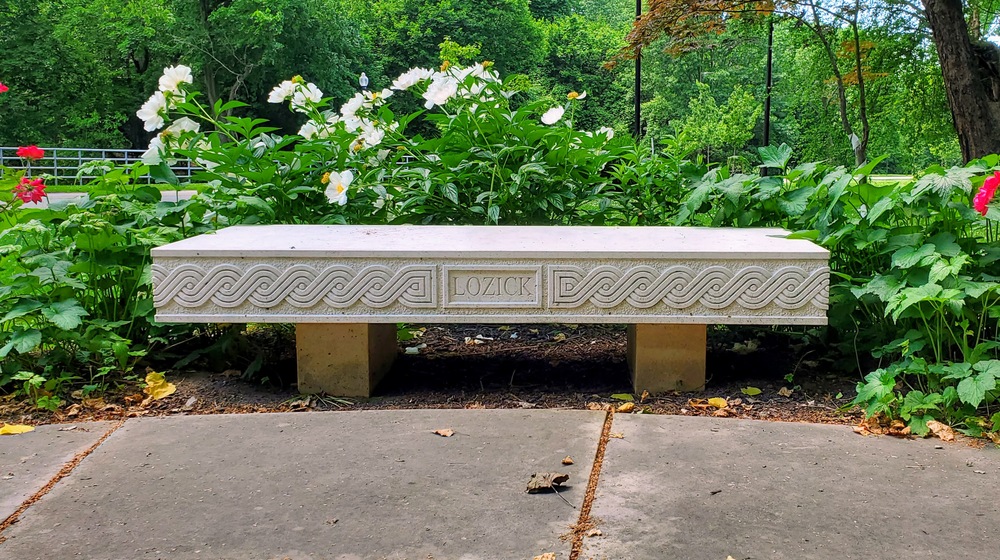Croatian Cultural Garden

The Croatian Cultural Garden is situated between the Hebrew and the Hungarian Gardens at the Cleveland Cultural Garden to pay homage to Cleveland’s Croatian community. Discussions concerning creating a new garden to showcase Croatian heritage began in early 2010 with a meeting between the Croatian Heritage Museum library staff and a special committee who initiated its construction. Our Croatia Inc. was the sponsoring organization for this garden. Construction on the Croatian Cultural Gardens started in April 2011 after some land from the British Cultural Garden was permitted to be used for the Croatian garden.
There was certainly a desire and need to reflect Croatia’s history in the Cleveland Cultural Gardens. The first wave of Croatian immigration to Cleveland occurred between the 1880s and World War I. It is estimated that there were around ten thousand Croatians in Cleveland by World War I. Croatians started coming to Cleveland from neighboring states because of construction and industry jobs being readily available in the area. Many Croatians left their homeland for Cleveland during this first wave due to financial constraints at home, as well as Austro-Hungarian rule. Prior to 1900, Croatian immigrants were predominately single men who moved to Cleveland. Many decided to settle along St. Clair Avenue from around East 24th Street to East 79th Street, as well as south to Superior and Payne Avenue. Moreover, many Croatians along with some Slovenians decided to settle in and around Nottingham, Euclid, Newburgh, Collinwood, and Maple Heights. Many were unskilled workers who worked for local companies: Van Dorn Iron Works, Patterson Sargent Paint Co, W.S. Tyler Plant, and Otis Steel. Many early Croatian immigrants were able to make a home and community for themselves in Cleveland.
Even more Croatian immigrants were inspired to move to Cleveland. There were a couple more waves of immigration with one large wave of immigration to the United States following World War II when many Croatians were fleeing a war-torn homeland and hoped for a better life in America. Another smaller wave of immigration to the United States in the mid-1960s to early 1970s occurred due to economic and political issues at home. According to the 1940 Census, there were an estimated 12,540 Croatians in Cleveland, and between 1967 and 1971, 8,000 Croatians immigrated to Cleveland. The Croatian population continued to grow in Cleveland and by 1985 the Croatian population grew to about 25,000. Due to the large population increase of Croatians, the cohesiveness of the Cleveland Croatians disintegrated into the broader Cleveland community. Despite this apparent fragmentation, Croatian immigrants and Croatian descendants still were and are connected through their churches and community organizations. There are currently 70,000 Croatian immigrants in Ohio, which demonstrates why a Croatian Cultural Garden was necessary and dedicated in 2012.
The design of this garden reflects Croatian history and culture. The lower plaza signifies Croatian folklore because it is formed like a licitar, a heart-shaped cake dating to the Middle Ages that is made from honey dough and wax. The licitar, a symbol of Croatia’s capital Zagreb, is made for special occasions. Many use licitars as ornaments on their Christmas trees and many will also give a licitar to someone on Valentine’s Day. The lower level also contains a 350-pound statue titled “Immigrant Mother.” Cleveland sculptor, Joseph Turkaly, was an immigrant from Croatia and wanted to create a statue that embodied the immigrant experience when he was an art teacher at Gilmour Academy, so he created this sculpture in 1985. The immigrant mother statue in the Croatian Cultural Gardens is not the only immigrant mother statue he has commissioned; there are immigrant statues he sculpted in Toronto, Canada; Buenos Aires, Argentina; Zagreb, Croatia; and in front of his Cleveland Heights home. There is text on the statue that is in Croatia’s original language Glagoltic and it states, “Dedicated to all the immigrant mothers who brought their families to America seeking freedom and a new life. Erected by the Croatian community of Greater Cleveland.” Furthermore, this statue contains a Croatian shield (Grb) and has a Croatian interlace pattern (Pletar) that represents the holy Trinity.
Moreover, there is an upper level to the garden that is conducive to gatherings due to its standard plaza shape. This level holds a baptismal font that illustrates when Croatia converted to Christianity and it replicates Prince Višeslav’s baptismal font. The American Croatian Women’s Club donated the six-sided font with the carved cross symbolizing the coming resurrection of Jesus. The font bears an inscription: “This font receives the weak to enlighten them. Here they are purged of their sins which they received from their first parents, to become Christians, salutary [sic] confessing the Eternal Trinity. This work was skillfully made by priest John at the time of Prince Višeslav, out of piety but to honor Saint John the Baptist, to mediate for him and his protégé.” This font was consecrated by Catholic priest Mirko Hladni of St. Paul’s Church on August 10, 2014, with Cleveland Mayor Frank Jackson in front of a crowd who came to see the garden. To connect this garden with Croatia even further, six benches were installed that were forged from Croatian Brac stone. The waterfall that flows from the upper to the lower level is meant to reflect of Croatia’s numerous waterfalls, such as Krka Falls and Plitvice Lake.
The Croatian Cultural Garden is a perfect representation of Croatia’s distinct history and reflects the strength that many Croatian immigrants had when immigrating to America. Their unique heritage is celebrated in these gardens because Croatians have been in Cleveland for over a hundred years. Croatia may be thousands of miles away from the Croatian Cultural Gardens, but anyone who visits this site today will feel a connection to Croatia that is undeniable.
Images










